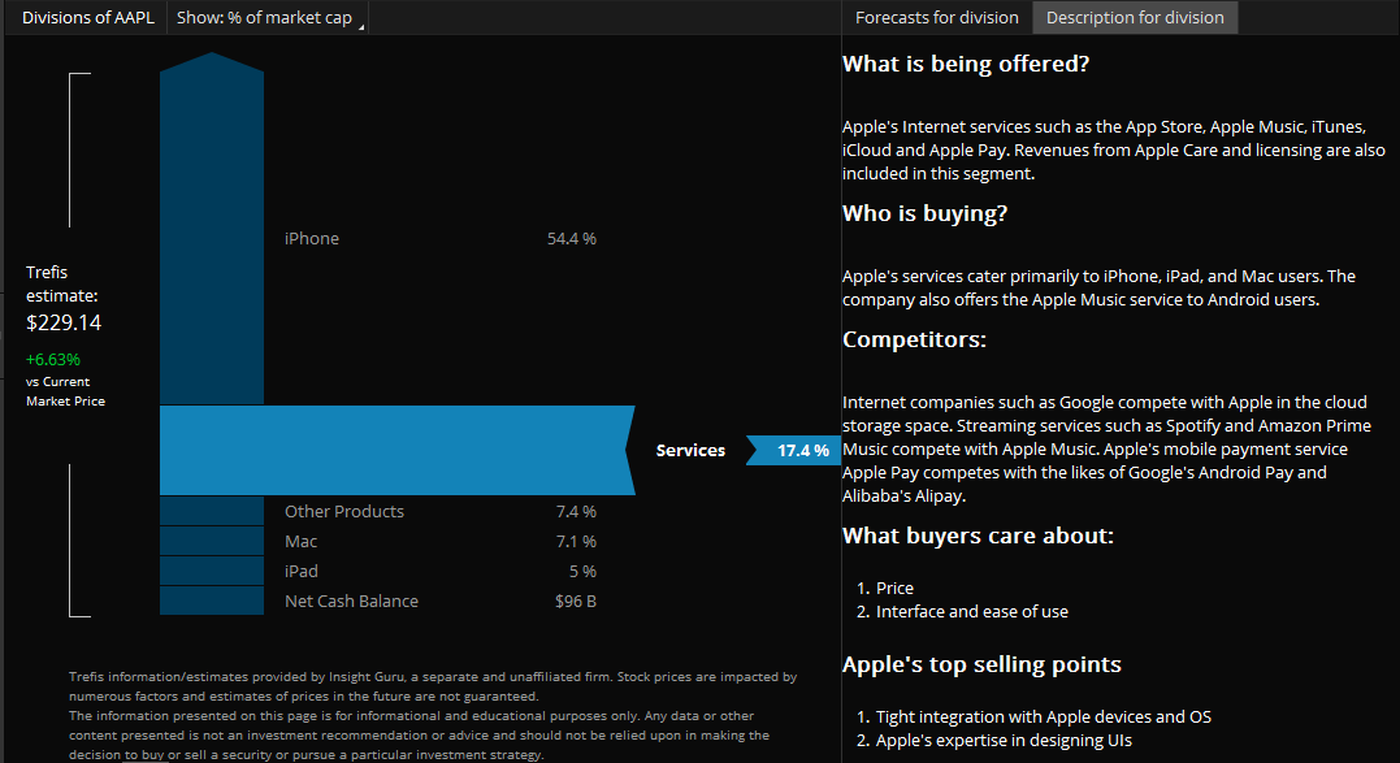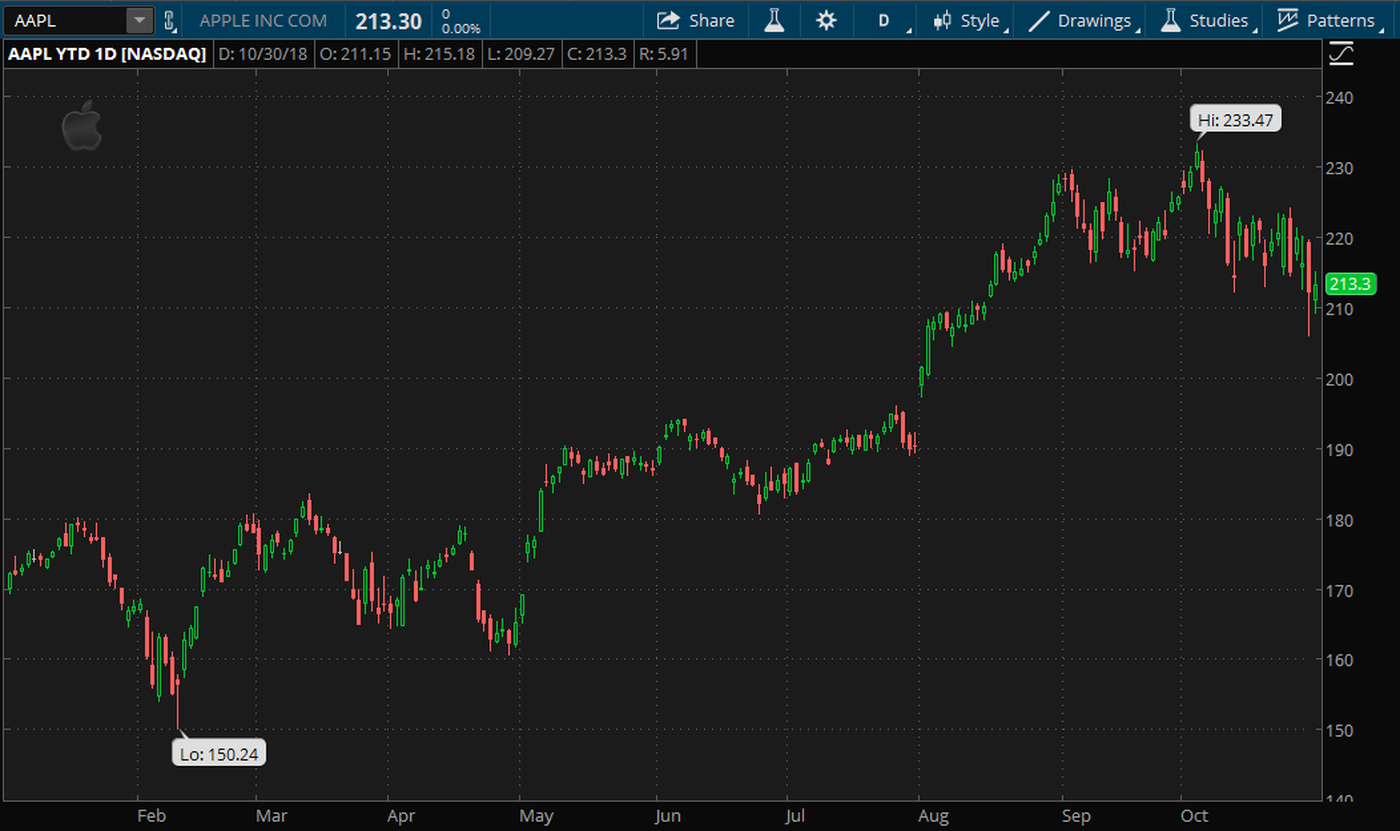Apple Inc. AAPL reports fiscal fourth-quarter earnings after the closing bell on Thursday, Nov. 1. Even with the recent pullback, shares are still up 23.8 percent year to date, handily beating the Nasdaq 100’s (NDX) 4.59 percent increase and the S&P 500’s (SPX) 0.49 percent decline.
With the stock not too far from all-time high, AAPL has gotten two upgrades in the past two weeks alone. And earlier in September, analysts at Bank of America and Morgan Stanley maintained buy/overweight ratings as well. With a series of upgrades, no sell ratings and hold ratings dropping steadily since the last report, AAPL has a lot of positive sentiment to live up to tomorrow.
For fiscal Q4, AAPL is expected to report adjusted EPS of $2.78 on revenue of $61.57 billion, according to third-party consensus analyst estimates. In the same quarter last year, it reported adjusted EPS of $2.07 on revenue of $52.58 billion.
AAPL’s own guidance calls for revenue of $60 billion to $62 billion, gross margin of 38 to 38.5 percent, and operating expenses of roughly $8 billion.
Per usual, management is likely to provide an update on share buybacks and dividend payments. During fiscal Q3, they said the company had paid out $3.7 billion in dividends and repurchased $20 billion worth of shares, bringing its buyback authorization to $90 billion at the end of the last quarter.
Another area that might come up on tomorrow’s call is China, as some of the company’s products have been impacted by tariffs. A growing number of analysts have also expressed concerns that Chinese government crackdowns on gaming, as well as signs of weakening consumer demand, pose potential short-term risks.
New Products and the Holidays
When AAPL last reported, the iPhone still made up a little over 50 percent of the company’s sales and remains its largest division by far. In fiscal Q3, AAPL sold 41.3 million iPhones, which generated $29.9 billion in revenue, a 20 percent year-over-year increase. Unit volumes were up 1 percent and average selling price (ASP) increased 20 percent to $724, which AAPL attributed to strong sales of higher-priced iPhone X and iPhone 8. Analyst consensus is for ASP to come in around $749 this quarter.
Earlier in the month, AAPL unveiled its newest lineup of iPhones. The two flagship models, the iPhone XS and XS Max went on sale Sept. 21, so a brief portion of their initial sales will be included in tomorrow’s results. While those models started at $1000 and topped out at $1449, the lower-priced iPhone XR wasn’t released until the end of October, putting any of its sales in the next report.
As is usually the case, many analysts have indicated they’re more focused on what guidance AAPL provides for the fiscal first quarter, parsing for clues about how many new iPhones management expects to sell during the holiday season. Currently, analyst consensus is expecting 100 million iPhones to be sold during the holiday quarter.
In addition to new iPhones, AAPL announced new Macs, MacBooks and iPad Pros at its Oct. 30 product launch event. Results from Macs and iPads have been mixed in recent quarters. In fiscal Q3, AAPL reported that Mac sales declined 13 percent year over year on a unit basis and 5 percent on a revenue basis; iPad sales increased 1 percent on a unit basis, but revenue dropped 5 percent.
The Other Products category, which includes the Apple Watch, Air Pods, Apple TV and more, has garnered more interest from analysts and investors as it has been the company’s fastest-growing division. Other Products’ revenue increased 37 percent year over year in fiscal Q3 to $3.74 billion.
Apple Services
AAPL’s Services business, which includes segments like the App Store and iCloud, has grown to become its second largest division by revenue. In its last report, Services revenue grew 31 percent year over year to $9.55 billion. Management’s stated goal is to get Services revenue to $51 billion per year by 2020.

Apple Services. AAPL’s Services business has grown to become the company’s second largest division behind the iPhone. In fiscal Q3, AAPL reported that Services generated $9.55 billion out of $53.27 billion in revenue. TD Ameritrade clients can analyze the revenue drivers of different companies on the Fundamentals tab on the thinkorswim® platform. Trefis information and estimates used in Company Profile are provided by Insight Guru, a separate and unaffiliated firm. Not a recommendation. For illustrative purposes only. Past performance does not guarantee future results.
The Services business has also been one of the factors in AAPL’s recent upgrades. Earlier this week, Jefferies’ analysts said they expect Services to comprise 25 percent of AAPL’s revenue and 40 percent of its gross profit by fiscal 2020, and think that portion of the business could be valued between $111 and $177 per share by then.
Apple Options Trading Activity
Options traders have priced in a 4.5 percent stock move in either direction around the earnings report, according to the Market Maker Move indicator on the thinkorswim® platform. Implied volatility is on the high, sitting at the 94th percentile as of this morning.

Apple 2018 Stock Chart. Even with the recent pullback, AAPL is still up 23.82 percent year to date heading into tomorrow’s report. After outperforming by a wide margin since 2017, the tech sector has been leading some of the recent declines as volatility picks up. AAPL’s earnings could be another factor that will play into market sentiment over the next few days. Chart source: thinkorswim® by TD Ameritrade. Not a recommendation. For illustrative purposes only. Past performance does not guarantee future results.
In short-term trading at the Nov. 2 weekly expiration, the 215-strike call as well as the 220-strike call have been heavily traded. On the put side, trading has been concentrated at the 210 strike price, a small amount above $206, where the stock has seen some support.
Looking at the Nov. 16 monthly expiration, again the 215 and 220 strike prices on the call side have been active in recent trading. For puts, the 205 and 215 strike prices have been active, with the highest open interest at the 205 strike.
Note: Call options represent the right, but not the obligation, to buy the underlying security at a predetermined price over a set period of time. Put options represent the right, but not the obligation to sell the underlying security at a predetermined price over a set period of time.
Information from TDA is not intended to be investment advice or construed as a recommendation or endorsement of any particular investment or investment strategy, and is for illustrative purposes only. Be sure to understand all risks involved with each strategy, including commission costs, before attempting to place any trade.
© 2025 Benzinga.com. Benzinga does not provide investment advice. All rights reserved.
Trade confidently with insights and alerts from analyst ratings, free reports and breaking news that affects the stocks you care about.